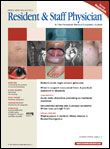Commentary: Orbital and Subcutaneous Emphysema
Jason G. Newman, MD
Assistant Professor
Gregory S. Weinstein, MD
Professor and Vice Chairman
Director, Division of Head and Neck Surgery
Department of Otorhinolaryngology, Head and Neck Surgery
University of Pennsylvania, Philadelphia
As the authors suggest, orbital emphysema is most commonly caused by trauma, and the air usually localizes at or near the fracture site. Other causes of this relatively rare phenomenon include infection, iatrogenic injury (sinus surgery), and pulmonary barotrauma. Spontaneous orbital emphysema caused by sneezing or aggressive nose blowing (as in this case) has been reported but is quite unusual.
The diagnosis of this condition can be made clinically or with imaging studies. Historically, plain radiographs were the diagnostic tool of choice. However, CT scanning is currently the most accurate means of diagnosis and will also localize the air bolus in the event of planned surgical decompression.
When evaluating a patient with orbital emphysema, it is necessary to ask about any recent or previous surgery or trauma to the area, current signs or symptoms of infection, or pain over the area. Physical examination should focus on visual acuity, range of motion, and the presence of pain with movement.
Treatment is based on the presumed etiology. In most instances, observation is all that is required. The air will resorb, and no intervention will be necessary. Many physicians, however, will tend to prescribe prophylactic antibiotics, because of the concern that the mucosal tear responsible for the air will also seed the area with sinonasal bacteria. In cases of infectious etiology, the source of the infection should be identified and treated appropriately. Ophthalmology, otolaryngology, or infectious diseases consultation may be appropriate.
Depending on the severity of the injury, surgical intervention or antibiotics may be considered. In rare cases, patients have been reported to develop retinal artery compression or compressive optic neuropathy.1 Should the patient demonstrate any evidence of visual compromise or decreased range of extraorbital motion, surgical consultation should be obtained. Needle or operative decompression of the air will most likely be necessary.
As in this case, unexpected causes of this phenomenon do occur, and the clinician needs to obtain a thorough and accurate history when no obvious cause of orbital emphysema exists.
Mayo Clin Proc.
1. Zimmer-Galler IE, Bartley GB. Orbital emphysema: case reports and review of the literature. 1994;69:115-121.
